
MISERMATIC
Installation and Maintenance Instructions
Hand these instructions to the user
Model No’s FRCM1G & FRCM2G are only for use on Natural Gas
(G20) at a supply pressure of 20 mbar in G.B. / I.E.

CONTENTS
Contents
Installation Instructions Page
Appliance Data 3
Section 1 1.1 Conditions of Installation. 4
1.2 Flue & Chimney Suitability 4
1.3 Fireplace/Surround Suitability 5
1.4 Shelf Position 5
1.5 Side Clearance 5
1.6 Closure Plate 5
1.7 Flue & Chimney inspection 5-6
1.8 Chimney Catchment space 6
1.8.1 Brick Built Chimney 6-7
1.8.2 Fitting to Pre-Fab. Twin Wall
Metal Flueboxes 7
1.8.3 Fitting to Pre-Cast Flue Installations 8
1.9 Hearth Fitting 8
1.10 Wall Mounting 8
1.11 Spillage Monitoring System 8
Section 2 2.1 Packing Check List 8
2.2 Installation of Fire 8-12
2.3 Gas Connection 12
2.4 Gas Soundness 13
.
Section 3 3.1 Completing the Assembly 13
3.2 Lighting the Appliance 13
3.3 Checking for Clearance of
Combustion Products 14
3.4 Final Checks 15
Section 4
Maintenance Instructions
4.1 General Access for Servicing 16
4.1.1 Removal of the Outer Case 16
4.2 Removal of the Burner Assembly 17
4.3 Removal of the Control Tap 18
4.4 Removal of the ODS 19
4.5 Removal / Replacement of the Radiants 19-20
2

APPLIANCE DATA
Main injector (1 off) Stereomatic Elbow size 76
Pilot Type. Copreci Single Flame 21100 / 161
Max. Gross Heat Input : 6.9 kW
Min. Gross Heat Input : 2.5 kW
Cold Pressure : 20.0 +/- 1.0 mbar (8.0 +/- 0.4 in w.g.)
Ignition : Rotary piezo, integral to gas valve
Electrode Spark Gap : 4.0 mm
Weight (Packed) : 24 kg
Firebox Dimensions (with case fitted)
Width: 800mm
Height: 636mm
Depth: 210mm
Height to top of the flue spigot : 525mm (with feet fitted)
Gas Connection : 8mm compression
(Supplied with fire)
Efficiency Declaration
The efficiency of this appliance has been measured as specified in
BS 7977-1 : 2002 and the result is 75%.
The gross calorific value of the fuel has been used for this efficiency
calculation. The test data from which it has been calculated has been certified by
Advantica. The efficiency value may be used in the UK Governments Standard
Assessment Procedure (SAP) for energy rating of dwellings.
3

1.1 CONDITIONS OF INSTALLATION
In Great Britain :-
It is law that all gas appliances are installed only by a registered installer in
accordance with these installation instructions and the Gas Safety (Installation and
use) Regulations 1998. Failure to install appliances correctly could lead to
prosecution. It is in your own interest and that of safety to comply with the law.
The installation must also be in accordance with all relevant parts of the Local and
National Building regulations where appropriate, the Building Regulations
(Scotland Consolidation) issued by the Scottish Development Department, and all
relevant recommendations of the following British Standard Code of Practice.
1. B.S. 5871. Part 1. Installation of Gas Fires.
2. B.S. 5440.: 2000 Parts 1 & 2. Installation of Flues & Ventilation.
3. B.S. 6891. Installation of Gas Pipework.
4. B.S. 6461. Part 1. Installation of Chimneys & Flues.
5. B.S. 1251. Open Fireplace Components.
6. B.S. 715. Metal Flue pipes for Gas Appliances.
7. B.S. E.N. 1858 Clay Flue blocks and Terminals.
8. B.S. 7566 Installation of factory-made Chimneys.
In Republic of Ireland :-
For use in I.E. this appliance must be installed in accordance with the rules
in force and used only in a sufficiently ventilated space. Please consult doc-
ument I.S. 813 : 1996 Domestic Gas Installation, issued by the National
Standards Authority of Ireland.
1.2 FLUE AND CHIMNEY SUITABILITY
The appliance is designed for use with conventional brick built chimneys or lined
chimneys and pre – fabricated flues. It is also suitable for use with pre-cast flue
blocks conforming to BS EN 1858 and metal flue boxes conforming to BS 715. All
flues must conform to the following minimum dimensions.
Minimum diameter of circular flues 125 mm
Minimum effective height of all flue types 3 metres
Minimum cross sectional area of Pre-cast Flues 122.7 cm
2
4

1.3 FIREPLACE / SURROUND SUITABILITY
The fire is suitable for hearth mounting or wall mounting. It must not
be fitted
directly onto a carpet or other combustible material. It must not be fitted to com-
bustible walls.
This fire is suitable for the following hearth / surround types:
Non-combustible hearths / surrounds.
Purpose made proprietary hearths / surrounds with a minimum temperature rating
of 150
o
C.
If a heating appliance is fitted directly against a wall without the use of a fire-
place or fire surround, soft wall coverings such as wallpaper, blown vinyl,
etc. could be affected by the heat and may, therefore scorch or become dis-
coloured. Please bear this in mind when installing or decorating.
1.4 SHELF POSITION
The fire may be fitted below a combustible shelf providing there is a minimum dis-
tance of 200 mm above the top of the fire and the shelf does not project more than
150 mm. If the shelf overhangs more than 150 mm the distance between the fire
and the shelf must be increased by 15 mm for every 25 mm of additional overhang
over 150 mm.
1.5 SIDE CLEARANCE
A minimum clearance of 70mm should be allowed on either side of the fire for
servicing. Any fire surround uprights should not project forward by more than
100mm.
NOTE. The fire must be installed so that no part of a combustible side wall when
measured laterally is less than 500mm from the radiants.
1.6 CLOSURE PLATE
A closure plate is supplied with this fire and must be fitted. The closure plate must
be sealed to the fireplace or surround opening with suitable adhesive tape. See
section 2.2.2
1.7 FLUE / CHIMNEY INSPECTION
Before commencing installation, a flue or chimney should be inspected to ensure
that all the following conditions are satisfied.
a) Check that the chimney / flue only serves one fireplace and is clear of
any obstruction. Any obstruction. Any dampers or register plates must
be removed or locked in the open position.
5

b) Brick / stone built chimneys and any chimney or flue which has been
used for an appliance burning fuel other than gas must be thoroughly
swept. The base of the chimney/flue must also be thoroughly cleared of
debris etc.
Any under floor air supply to the fireplace must be completely sealed off.
Ensure that the inside of the chimney/flue is in good condition along its length and
check that there is no leakage of smoke through the structure of the chimney dur-
ing and after the smoke pellet test.
With pre-cast flues it is especially important to check the inside of the flue
for extruded Cement / sealant protruding from the joints between the flue
blocks. If present, these should be removed by rodding the flue before pro-
ceeding with the installation.
Using a smoke pellet, check that there is a positive up draught present in the
chimney / flue and that the smoke can be seen issuing from the terminal / chimney
pot outside. There must be no leakage of smoke through the structure of the chim-
ney during or after the smoke pellet test and it is important to check inside upstairs
rooms adjacent to the chimney / flue. Check the chimney pot / terminal and gener-
al condition of the chimney brickwork or masonry. If the chimney or flue is in poor
condition or if there is no up draught do not proceed with the installation. If there is
a history of down draught conditions with the chimney / flue, a tested and certified
flue terminal or cowl suitable for the relevant flue type should be considered.
A spillage test must always be carried out during commissioning of the
appliance.
1.8 CHIMNEY CATCHMENT SPACE.
1.8.1 Brick Built Chimneys.
The catchment space below the flue spigot should be as deep as possi
ble, and must not be less than 250mm measured from the bottom of the
flue spigot to the bottom of the catchment space, or to the top of any
“bricking-up” of the fireplace, whichever is the least. See Fig. 1.
The flue spigot must pass through the closure plate at least 25mm and
have a minimum clearance of 50mm between its open end and the
nearest obstruction. There must be a minimum clearance of 165mm
between the back of the closure plate and the back of the catchment
space. See Fig. 1 overpage.
6

The front opening of the fireplace must be between 305mm and 440mm
wide, and between 522mm and 650mm high. If the opening is larger
than this, then a surround must be constructed in a suitable non-com
bustible material to create an opening to these limits. Allow a minimum
flat surface of 20mm around the opening to ensure that the closure
plate can be sealed to the fireplace.
Any surround must be sealed to the fireplace to prevent leakage. The
operation of the chimney should be tested a detailed as in section 1.7.
Note. A flue spigot extension of up to a maximum total length of 125mm
may be fitted if necessary, providing that a minimum clearance
50mm between its open end and nearest obstruction is always
maintained.
Fig.1. Chimney Catchment Space.
1.8.2 Fitting to Pre-Fabricated twin wall metal Flue Boxes.
The appliance may be fitted to a twin wall metal flue box conforming to
the constructional requirements of BS 715, (for example the Selkirk LFE
125 box). The box must have a minimum flue diameter of 125mm
internal and minimum internal dimensions of 160mm deep by 580mm
high by 350mm wide. There are no maximum dimensional requirements
for the box. The top face of the box must be insulated with a minimum
thickness of 50mm of non-combustible mineral wool insulation or similar
material. The flue box must stand on a non-combustible base of
minimum thickness 12mm.
1.8.3 Fitting to Pre-Cast Flue Installations.
The appliance is suitable for use with pre-cast flues conforming to B.S.
EN 1858. The pre-cast opening must be a minimum of 122.7cm
2
or
equivalent cross-sectional area and have a minimum effective flue
height of 3 metres. The flue spigot restrictor must be removed when
installing into pre-cast flue applications
7

This appliance has been tested for use in a pre-cast flue block complying
with BS EN 1858. In accordance with BS EN 1858, pre-cast flues built with
directly plastered faces (front or rear) are not correctly installed as to ensure
proper operation with any type of gas fire. In some instances of this flue
construction, temperature cracking of surface plaster may occur through no
fault of the appliance. An air gap or some form of insulation material should
be installed to prevent normal flue temperatures from damaging wall
surfaces.
1.9 HEARTH FITTING
This appliance must only be installed on to a level concrete or non-
combustible hearth The feet must not be removed.The hearth material
must be a minimum thickness of 13 mm with the top surface at least 50
mm above the floor level. The hearth must be fitted symmetrically about
the fire opening and have a minimum width of 760 mm and a minimum
projection of 300 mm forwards from the fire opening.
1.10 WALL MOUNTING
The fire can be fitted to non-combustible walls. The base of the fire
must be at least 150mm above the floor level with the top of the fire
place opening being at least 550mm above the floor level.
The wall should be plugged and the fire secured to the wall with suitable
screws. See” Wall Mounting” in the installation section.
1.11 SPILLAGE MONITORING SYSTEM
This appliance is fitted with an atmosphere sensing spillage monitoring
system in the form of an oxygen sensing pilot. This is designed to shut
the fire off in the event of partial or complete blockage of the flue
causing a build up of combustion products in the room in which the fire
is operating. The following are important warnings relating to the
spillage monitoring system:
The spillage monitoring system must not be adjusted by the
Installer.
The spillage monitoring system must not be put out of action.
When the spillage monitoring system is exchanged, only a complete
original Manufacturers part may be fitted. It is not possible to replace
individual parts on the pilot system on the appliance, only a complete
pilot assembly (including thermocouple) may be fitted.
8

2.1 PACKING CHECK LIST
1 off Firebox / Burner Assembly
1 off Flue Spigot
1 off Closure Plate
1 off Literature / Loose Items Pack
1 off Pack of Screws & Fixings for Wall Mounting
4 off Ceramic Radiants – Packed inside firebox
2 off Self adhesive foam rubber discs
2.2 INSTALLATION OF FIRE
2.2.1 Preparation.
a) Remove the dress guard by springing the location wires out at the top
and lifting away. See Fig. 2 Take care not to scratch the trim.
b) Remove the radiants and their packaging from inside the fire and store
in a safe place.
c) Remove the two lower outer case fixing screws. See Fig. 3, and the two
upper outer case fixing screws (Fig. 4)
Remove the outer case by lifting upwards and away, ensuring the rear
of the outer case clears the top of the control spindle area at the
right-hand side. NOTE- the control knob bezel must be removed
before refitting the outer case. The bezel can then be fitted with the
outer case in position.
d) Remove the ancillary parts from the packaging.
e) Fit the control knob.
Fig. 2 Remove the Dress Guard.
9

Fig. 3 To Remove the Lower Outer Case Fixing Screws
Fig. 4 Remove the Upper Outer Case Fixing Screws
f) Remove the flue spigot restrictor if the fire if the fire is the to be fitted: to
a pre cast flue.
The flue spigot restrictor is attached to the fire back with two screws.
g) Fit the flue spigot (or Optional extended flue spigot) to the back panel
using four screws
10

Closure plate.
a) Fit the closure plate to the fireplace opening and ensure that it has a flat
sealing area of at least 10mm sealed on all sides. See diagram below
Dimensions stated are for closure plate supplied
Check the operation of the chimney as follows:-
Apply a smoke match to the flue spigot opening in the closure plate and observe
the smoke. If there is a definite flow into the opening then proceed with the instal-
lation. If there is not a definite flow into the opening, pre-heat the chimney for
about two minutes and retest for flow. If there still is no definite flow into the open-
ing, the chimney may require attention. DO NOT FIT THE FIRE-SEEK EXPERT
ADVICE.
Hearth Fitting
a) The feet must be fitted when hearth fitting.
Note
: When the fire is to be fitted onto a very smooth surface eg marble or
tiles.
The 2 off self adhesive foam rubber discs, supplied should be stuck on
to the levelling screws at the front of the fire.
b) Carefully place the fire on the hearth. Slide the fire backwards up to the
closure plate, ensuring that the flue spigot passes through the hole In
the closure plate.
c) Level the fire by adjusting the levelling screws at the front of the feet.
d) Proceed with the gas connection as in section 2.3
Minimum 10mm
Flat Sealing Area
Spigot Opening
660mm
460mm
493mm to
CTR
522mm Minimum
650mm Maximum
Fireplace
Opening
Dimensions
C
losure
P
late
Dimensions
305mm Minimum
440mm Maximum
11

Wall Mounting. (Non Combustible Walls Only)
NOTE: When the fire is wall mounted, the base of the fire must be a least
150mm above the floor level.
a) Remove the feet from the base of the fire. (4 screws in each.)
b) Mark the position of the upper fixing holes on the wall with reference to
fig. 5. The height of the upper holes should be at least 585mm above
the floor. This will determine the 150mm height required from the base
of the fire to the floor.
c) Drill and plug the upper holes with the wall plugs supplied.
d) Offer the fire to the wall and push the spigot on the rear of the fire
through the opening in the closure plate.
e) Fit the 4 screws through the holes in the firebox back panel and tighten
to secure the fire to the wall
f) Proceed with the gas connection as in section 2.3.
Fig. 5 Marking out Fixing Screw Position
2.3 GAS CONNECTION
Note :
A means of isolation must be provided near to the appliance to facilitate
servicing.
Ensure that the gas supply is turned off before commencing.
The gas connection should be made to the appliance inlet elbow using 8 mm rigid
tubing. The gas connection can be made left hand, right hand or rear
42mm
600mm
435mm
150mm Minimum
Upper Fixing Screw
Positions (Keyhole
Slots)
Lower Fixing
Screw Positions
12

Before making the final gas connection, thoroughly purge the gas supply
pipe work to remove all foreign matter, otherwise serious damage may be
caused to the gas control valve on the fire.
2.4 GAS TIGHTNESS
a) Remove the pressure test point screw from the inlet elbow and fit a
manometer.
b) Turn on the main gas supply and light the fire as described in section
3.2 and carry out a gas tightness test.
c) Check that the gas pressure is 20.0 mbar (± 1.0 mbar), 8.0 in w.g. +/-
0.4 in w.g.
d) Turn off the fire, remove the manometer and refit the pressure test point
screw. Check the pressure test point screw for gas tightness with the
appliance turned on using a suitable leak detection fluid or detector.
3.1 Completing the Assembly
a) Fit the radiants by carefully inserting the upper end first into the radiant
canopy, and then lowering and seating the base of the radiants into the
radiant support channel.
b) Pull off the control knob.
c) Fit the outer case by hooking rear edge of the case over the retaining
lugs at each end of the rear panel.
d) Ensure that the control bezel situated in the right hand side of the case
clears the control valve spindle.
e) Re-fit the outer case fixing screws situated at the front as shown in Fig.
3 & 4 (page 9 &10 respectively)
f) Refit the control Knob.
3.2 Lighting the Appliance
a) Light the pilot by depressing the control knob at the “off” position and
turn anti-clockwise (with the control depressed) to the second position
marked *.
b) When the pilot lights, (pilot can be seen through the bottom window of
right hand radiant) hold the control knob down for 10 seconds.
c) If the pilot fails to light, repeat the ignition sequence and hold in the
control knob for slightly longer.
d) When the pilot has lit, release the control knob from the depress
position, depress slightly again and turn the control anti-clockwise to the
large flame position and check for clearance of combustion products as
detailed below.
13

3.3 Checking for Clearance of Combustion Products
Note
: This test should be carried out with the case removed to prevent
staining.
a) Close all doors and windows in the room.
b) Light the fire and turn to the maximum position.
After 5 minutes hold the smoke match as shown in Fig. 6. Whilst hold
ing the smoke match in the correct position, approximately 10mm below
and inside the lower edge of the centre of the canopy. See Fig 6.
Ensure that most of the smoke is drawn into the flue aperture. If in
doubt repeat the exercise after a further 5/10 minutes.
Note:- It is recommended that the smoke match is fitted into an approved
smoke match holder, when checking for clearance of combustion
products.
Fig. 6
e) If the smoke is not drawn into the flue aperture, remove the flue spigot
restrictor if fitted and repeat the spillage test.
If there is an extractor fan fitted in a joining room, then the spillage test must be
repeated with the fan switched on and running at maximum speed. All intercon-
necting doors must be opened in accordance with the latest issue of BS 5440.
IF SPILLAGE IS DETECTED
The cause must be discovered and the fault corrected. If the fault cannot be cor-
rected disconnect the appliance from the gas supply and seek expert advice.
Possible causes of spillage from the appliance are:- chimney restriction, down
draught or insufficient air supply to the room.
g) After ensuring that the fire is safe to use it should be left on “High”
position to fully warm up. During this time a slight odour may be
noticed, this is due to the “newness” of the fire and will soon disappear.
14

3.4 Final Check
a) Refit the Dress-guard.
b) Recheck the operation of the fire on all settings.
c) Make sure that the User knows how to operate the fire and refer them
to the User Book.
d) Inform the User that the Model Number for ordering parts is shown on
the Rating plate. This is located on the inner face of the rear panel at
the left-hand side. This can be viewed through the upper grille.
e) Inform the User the fire should be serviced annually for continued safe
operation.
f) Hand this instruction booklet to the customer.
PARTS SHORTLIST
Replacement of parts must be carried out by a competent person such as a
CORGI registered gas installer. The part numbers of the replaceable parts are as
follows, these are available from your local Flavel stockist, whose details can be
found on the BFM Europe website, address on the back page
Ceramic Radiant Plaques B-48680
Gas Valve with integral ignition & lead B-49000
Control knob B-48590
ODS Pilot Assy B-48360
Closure plate 1C-48740
15

MAINTENANCE INSTRUCTIONS
Servicing Notes
Servicing should be carried out annually by a competent person such as a
Corgi registered engineer.
The service should include visually checking the chimney and fire opening for
accumulations of debris and a smoke test to check for positive up-draught in
the chimney.
The condition of the ceramic should be checked and if necessary the whole
set should be replaced with a genuine replacement set.
After any servicing work a gas tightness check must always be carried out.
4.1 GENERAL ACCESS FOR SERVICING
4.1.1 TO REMOVE THE OUTER CASE.
a) Prepare work area (lay down dustsheets etc.)
b) Remove control knob.
c) Remove two lower outer case fixing screws, and the two upper outer
case fixing screws (see fig.7 & 8) and lift the case upwards and away.
d) Remove the radiants and move to a safe place
e) Re-assemble in the reverse order.
Fig. 7 Removing the Lower Outer Case Fixing Screws
16

Fig. 8 Removing the Upper Outer Case Fixing Screws
4.2 REMOVING THE BURNER ASSEMBLY FROM THE FIRE
a) Remove the outer case as section 4.1
b) Unscrew the pilot from the pilot bracket attached to the burner. See
section 4.3
c) Unscrew injector fixing bracket. See fig. 9
d) Unscrew four burner fixing screws. See fig. 10
e) Carefully prise the injector to the right and out of the burner.
f) Carefully remove the burner.
g) Re-assemble in the reverse order.
h) Check for gas soundness.
Fig. 9 Injector fixing bracket removal
17

Fig. 10 Burner removal
4.3 REMOVING THE CONTROL TAP FROM THE FIRE
a) Remove the outer case as section 4.1
b) Remove the service plate from the control valve air duct by unscrewing
the two screws. See fig. 11
c) Unscrew the control valve lock-nut from the top of the control valve.
d) Unscrew the two control valve panel fixing screws fig. 12 and remove
valve and panel.
e) Loosen and remove the three gas pipe retaining nuts from the control
valve and release the ends of the gas pipes from the control valve body.
f) Remove the thermocouple by pulling down straight on the push fit
connector.
g) Re-assemble in the reverse order
Fig. 11 Service Plate Removal
Position of Burner
Screws
18

Fig. 12 Control Valve Panel Removal
h) To refit the control valve, reassemble in reverse order noting that the
control tap locates with a flat in the control fixing panel. Carry out a gas
soundness test after re-assembly.
4.4 REMOVING THE ODS- PILOT ASSEMBLY
Note : Because this appliance is fitted with an atmosphere sensing ODS-pilot
it is not possible to replace the thermocouple separately, because the ther-
mocouple position is factory set to a tight tolerance. Any replacement of
parts on the pilot requires a complete new pilot assembly.
a) Loosen the gas pipe nut and remove gas pipe from the pilot. This can
be accessed from under the base of the fire.
b) Unscrew the pilot fixing screws. These can be accessed either from
under the base of the fire, or from the rear of the fire via two cut-outs in
the rear panel.
c) Remove the push fit thermocouple as described in section 4.3.
4.5 REMOVAL / REPLACEMENT OF THE RADIANTS
Remove the radiants by lifting them slightly then pulling forward as shown
in Fig. 13 overpage
19

Fig. 13
REPLACING THE RADIANTS
When replacing the radiants, always ensure that they are correctly located as
shown in Fig. 14 below.
Fig. 14
Due to our policy of continual improvement and development the exact
accuracy of illustrations and descriptions contained in this book cannot be
guaranteed.
20
Front edge of the Positioning Plate
Ensure that the rear face of
the ceramic radiant is touching
the front edge of the position-
ing plate as indicated
Page is loading ...
Page is loading ...
Page is loading ...
Page is loading ...
Page is loading ...
Page is loading ...
Page is loading ...
Page is loading ...
-
 1
1
-
 2
2
-
 3
3
-
 4
4
-
 5
5
-
 6
6
-
 7
7
-
 8
8
-
 9
9
-
 10
10
-
 11
11
-
 12
12
-
 13
13
-
 14
14
-
 15
15
-
 16
16
-
 17
17
-
 18
18
-
 19
19
-
 20
20
-
 21
21
-
 22
22
-
 23
23
-
 24
24
-
 25
25
-
 26
26
-
 27
27
-
 28
28
Flavel FRGCP0EN Installation And Maintenance Instructions Manual
- Type
- Installation And Maintenance Instructions Manual
- This manual is also suitable for
Ask a question and I''ll find the answer in the document
Finding information in a document is now easier with AI
Related papers
-
Flavel Renaissance Gas Fire User manual
-
Flavel REGENT L.F.E. Installation And Maintenance Instructions Manual
-
Flavel Misermatic FRCM1G Installation And Maintenance Instructions Manual
-
Flavel Real Wood High Efficiency Gas Fire User manual
-
Flavel Strata Outset Gas Fire User manual
-
Flavel REGENT L.F.E. Installation And Maintenance Instructions Manual
-
Flavel Outset Radiant Heat Gas Fire User manual
-
Flavel Welcome Outset Gas Fire User manual
-
Flavel Regent Installation And Maintenance Instructions Manual
-
Flavel RENAISSANCE RETRO Installation, Maintenance & User Instructions
Other documents
-
Kmart 42311256 User manual
-
Kmart 42913450 User manual
-
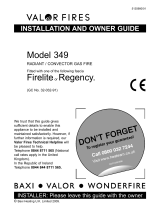 Valor Fires 349 Installation and Owner's Manual
Valor Fires 349 Installation and Owner's Manual
-
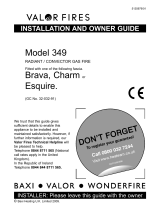 Valor Fires 349 Installation guide
Valor Fires 349 Installation guide
-
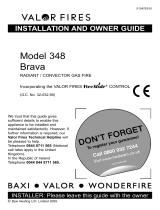 Valor Fires 348 Brava Installation and Owner's Manual
Valor Fires 348 Brava Installation and Owner's Manual
-
Valor BLACK BEAUTY 348 Installer And Owner Manual
-
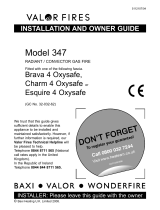 Valor Fires 347 Installation and Owner's Manual
Valor Fires 347 Installation and Owner's Manual
-
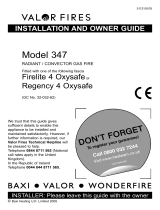 Valor Fires 347 Installation and Owner's Manual
Valor Fires 347 Installation and Owner's Manual
-
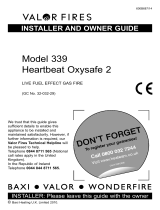 Valor Fires 339 Installer And Owner Manual
Valor Fires 339 Installer And Owner Manual
-
Baxi Fires Division 341 black beauty slimline Installation Instructions Manual

































